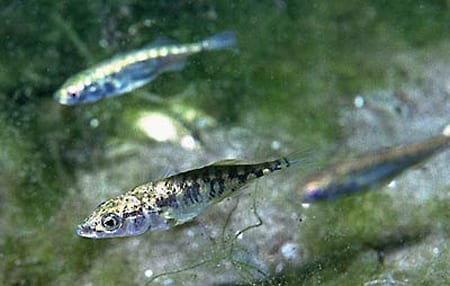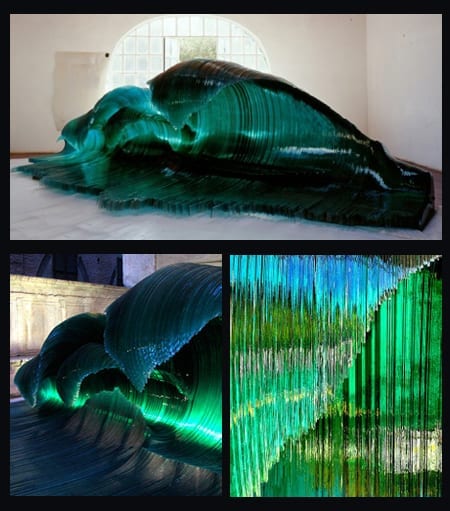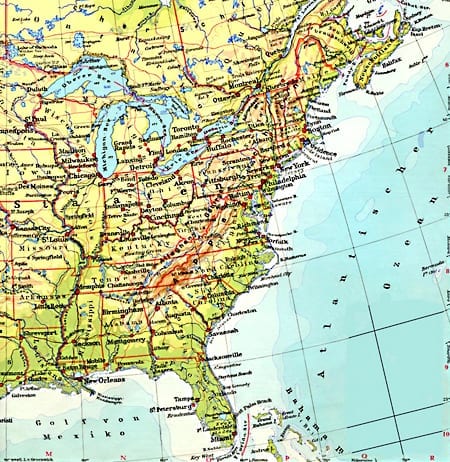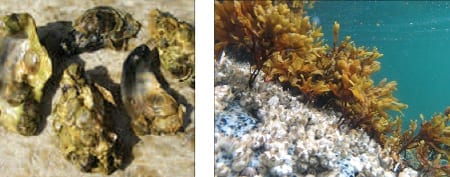March 2013 is furiously peeling off days from the calendar, desperate to pass the torch on to other months, other seasons. Time these days feels radically non-linear, we better post some news about the oceans and acidification this very day:
•According to a new paper published in Nature Geoscience predators could play a role in CO2 emissions on freshwater ecosystems:
“Predators can influence the exchange of carbon dioxide between ecosystems and the atmosphere by altering ecosystem processes such as decomposition and primary production, according to food web theory. […] Here, we report experiments in three-tier food chains in experimental ponds, streams and bromeliads in Canada and Costa Rica in the presence or absence of fish (Gasterosteus aculeatus) and  invertebrate (Hesperoperla pacifica and Mecistogaster modesta) predators. We monitored carbon dioxide fluxes along with prey and primary producer biomass. We found substantially reduced carbon dioxide emissions in the presence of predators in all systems, despite differences in predator type, hydrology, climatic region, ecological zone and level of in situ primary production. We also observed lower amounts of prey biomass and higher amounts of algal and detrital biomass in the presence of predators. We conclude that predators have the potential to markedly influence carbon dioxide dynamics in freshwater systems.”
invertebrate (Hesperoperla pacifica and Mecistogaster modesta) predators. We monitored carbon dioxide fluxes along with prey and primary producer biomass. We found substantially reduced carbon dioxide emissions in the presence of predators in all systems, despite differences in predator type, hydrology, climatic region, ecological zone and level of in situ primary production. We also observed lower amounts of prey biomass and higher amounts of algal and detrital biomass in the presence of predators. We conclude that predators have the potential to markedly influence carbon dioxide dynamics in freshwater systems.”
SOURCE
•Ocean wave made of glass by Italian artist Mario Cerolli
•How US East Coast regions react to Ocean Acidification: A new large study conducted by scientists from 11 US institutions around the Eastern US and the Gulf of Mexico will help researchers understand how different bodies of water will be affected by changes in acidity.
“Before now, we haven’t had a very clear picture of acidification status on the east coast of the U.S.,” says Zhaohui ‘Aleck’ Wang, the study’s lead author and a chemical oceanographer at Woods Hole Oceanographic Institution (WHOI). “It’s important that we start to understand it, because increase in ocean acidity could deeply affect marine life along the coast and has important implications for people who rely on aquaculture and fisheries both commercially and recreationally.”
According to the survey different regions of coastal ocean will respond to an influx of CO2 in different ways. “If you put the same amount of CO2 into both the Gulf of Maine and the Gulf of Mexico right now, the ecosystem in the Gulf of Maine would probably feel the effects more dramatically,” says Wang. “Acidity is already relatively high in that region, and the saturation of calcium carbonate—the mineral that many organisms need to make shells—is particularly low. It’s not a great situation.”
Wang goes on to explain that excess CO2 can enter coastal waters from a variety of different sources. One large source is carbon dioxide in the atmosphere. Another potential culprit is nutrient-rich runoff from land. Rainfall and other surface flows can wash fertilizers and other byproducts of human activities into river systems and ground water, and ultimately, into the coastal ocean, delivering an excess of nutrients and often an explosion of biological activity that can lead to decreased oxygen and increased CO2 and acidity. As he points out, ‘this happens regularly in the Gulf of Mexico,” says Wang. “The Mississippi River dumps enormous amounts of nitrogen and other nutrients into the Gulf, which spawns large algal blooms that lead to production of large amount of organic matter. In the process of decomposing the organic matter, the microbes consume oxygen in the water and leave carbon dioxide behind, making the water more acidic. If this process happens in the Gulf of Maine, the ecosystem there may be even more vulnerable since the Gulf of Maine is a semi-enclosed system and it may take longer time for low pH, low oxygen water to disperse.”
After analyzing their data, Wang and colleagues found that, despite a “dead zone” of low oxygen and high acidity outside the mouth of the Mississippi, the Gulf of Mexico on the whole showed a high ratio of alkalinity to DIC, meaning it would be more resistant to acidification. As the team travelled farther north, however, they saw the ratio steadily decreases north of Georgia.
In the study the waters in the Gulf of Maine on average had the lowest alkalinity to DIC ratio of any region along the eastern seaboard, meaning that it would be especially vulnerable to acidification. While it’s unclear exactly why the ratio of alkalinity to DIC is low in those northern waters, Wang believes part of the issue may be linked to alkalinity sources to the region. For example, the Labrador Coastal Current brings relatively fresh, low alkalinity water down from the Labrador Sea to the Gulf of Maine and Middle Atlantic Bight. If this current is the major source of alkalinity to the region it may mean that the Gulf of Maine’s fate could be linked to changes in global climate that, through melting sea ice and glaciers, increase the flow of fresh water to the Gulf of Maine. However, whether this freshening is accompanied by a decrease in seawater alkalinity and “buffer” capacity remains unknown.
Since the waters of the northeast U.S. are already susceptible to rising acidity in Wang’s opinion this raises big questions about how species of marine life will fare in the future. “For example, how are oysters going to do? What about other shellfish? If the food chain changes, how are fish going to be impacted? There’s a whole range of ecological and sociological questions.” There is a great need for need for more robust coastal ocean chemistry monitoring and coastal ocean acidification studies, he adds. A better understanding of the changing chemistry will help fisheries regulators to better manage the stocks.
SOURCE 1
SOURCE 2
•Get more than a penny for your thoughts: “The Paul G. Allen Family Foundation, as part of a larger ocean health initiative, and in collaboration with The Oceanography Society, is offering a $10,000 prize for the most promising new science-based concept for mitigating environmental and/or societal impacts of ocean acidification.
In addition to the prize, the authors of highly ranked concepts will receive invitations to submit full proposals to the Paul G. Allen Family Foundation for funding consideration.”
“The Foundation seeks concepts that would provide a better understanding of the impact of ocean acidification on different parts of the marine ecosystem and mitigation strategies that might reduce the environmental or societal impacts of ocean acidification. Concepts may focus on natural processes and/or human activities that benefit society. They can be global, regional, or local in scope, and may address a single species/activity or whole ecosystems/industries. While submissions must be firmly rooted in science and should include elements of new basic research, concepts must show a high probability of leading to future demonstrations of a new capability. Preference will be given to interdisciplinary efforts that seek to apply concepts across traditional disciplinary boundaries.
Submissions may come from anyone, regardless of nationality or institutional affiliation, and may represent individuals or teams.”
Download the Ocean Challenge Overview PDF HERE
Or read the details HERE
•Free seminar on Ocean Acidification on Wednesday, March 13, in Anacortes, WA. Taking place at the Seafarers’ Memorial Park Building between 6 and 8 PM, members of the Puget Sound Partnership Ecosystem Coordination Board, Shannon Point Marine Center, Tailor Shellfish Farms and the Sustainable Fisheries Partnership will explain the problem of Ocean Acidification, talk about how shellfish are coping with it and offer recommendations, partnerships and actions.
More info HERE
•The California Academy of Sciences has put up a new Youtube video on Ocean Acidification:
•The Coastal America Partnership will be hosting its 4th Student Summit on the Oceans and Coasts from March 9-11 in Washington DC, bringing “students from around the US, Canada and Mexico to Washington, DC, to raise awareness of coastal issues and to promote stewardship of our ocean.”
“The March 11th Student Presentation Day at the Smithsonian Institution’s National
Museum of Natural History’s (NMNH) Baird Auditorium is open to the public. To
amplify the learning opportunity, this event will also be made
public through a live webcast over the Smithsonian’s Institution’s
Ocean Portal at www.ocean.si.edu/CoastalAmericaStudentSummit” from 9:00 a.m. – 5:30 p.m. EST. The webcast presents a unique
opportunity for students, educators and the public to watch from
locations throughout the world as these young students make
their voices heard in our nation’s capital.”
SOURCE
•“The second U.S. Ocean Acidification Principal Investigators’ Meeting will be held in Washington, DC at Gallaudet University’s Kellogg Conference Center on September 18-20 2013. This three-day meeting will bring together the U.S. OA research community to assess the state of OA science nationally and to identify knowledge gaps and opportunities for collaborations that will accelerate OA research in the future.
This meeting offers an opportunity for the scientific community to help shape U.S. national OA research efforts as they develop. In addition to poster sessions to showcase scientific results, meeting activities include numerous panel, plenary, and breakout discussions designed to explore how current U.S. OA research and organizational support fit together, and to identify where greater synergies can be encouraged.”
SOURCE and MORE INFO
•At least we have laughter to save us from despair when not insanity: “the Tea Party Manatee-Riding Patriots”:


